PDF Version
July 2015
This document presents data on business lending activities gathered from the Statistics Canada Biannual Survey of Suppliers of Business Financing, the Bank of Canada Senior Loan Officer Survey and Business Outlook Survey, and the PayNet Canadian Business Lending Index.
Summary
- Overall lending conditions in Canada improved in the second half of 2014 (July to December) as supplierscontinued to lend aggressively across all business size categories and sectors.
- Lending conditions improved the most for large businesses (those with loan authorization levels of $5.0 million or more), with the value of loan disbursals increasing by 11.7-percent from first half of 2014 to the second half of 2014.
- SMEs in transportation, professional services, and "other" sectors benefitted most from the increased lending.
Overall lending conditions
Results from the Survey of Suppliers of Business Financing highlight a continued increase in value of credit disbursements in the second half of 2014. In total, lenders disbursed approximately $88 billion in new loansFootnote 1 to Canadian businesses between July and December (H2 2014), compared with approximately $80 billion in new loans disbursed between January and June 2014 (H1 2014) (Figure 1). This translates into an increase in new loan activity of 9.6-percent from H1 2014 to H2 2014 and reflects four years of straight increases and the highest rate of growth since 2011.
Figure 1: Value of Credit Outstanding ($ billions) and Disbursed ($ billions) to All Businesses
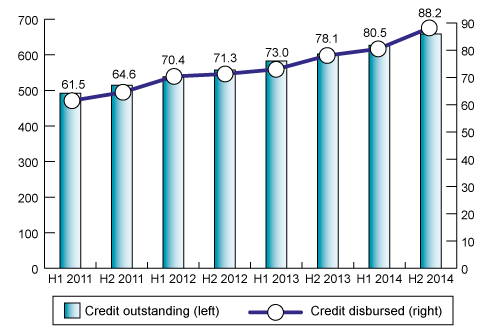
Source: Statistics Canada, Biannual Survey of Suppliers of Business Financing, 2014.
The total value of credit outstanding has also continued to increase since 2011 as growth in new loan disbursals hasoutpaced growth in loan repayments.
Results from the Survey of Suppliers of Business Financing are consistent with an overall loosening in business lending conditions reported by the Bank of Canada. As can be seen in Figure 2, credit conditions in Canada have been eased since 2011 with both the Bank of Canada's Senior Loan Officer Survey and Business Outlook Survey lending indexes reporting easing credit conditions. This stands in sharp contrast to the financial crisis/recessionary period of 2007 to 2009 in which credit markets were clearly in a state of tightening.
Figure 2: Credit Lending Conditions in Canada
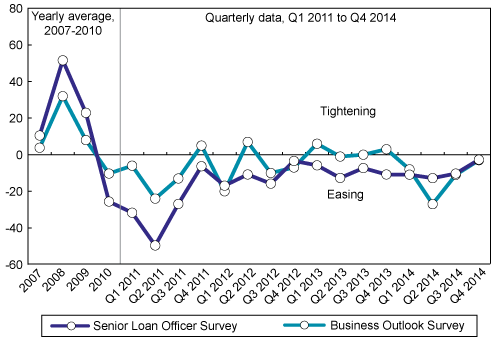
Sources: Bank of Canada, Senior Loan Officer Survey and Business Outlook Survey, 2015.
Note 1: The Senior Loan Officer Survey lending index shows the difference between the weighted percentage of financial institutions reporting tighter credit conditions and the weighted percentage reporting easier credit conditions in the preceding 3 months. The Business Outlook Survey lending index shows the percentage of firms reporting tighter lending terms and conditions minus the percentage reporting easier terms and conditions compared with the previous 3 months.
Note 2: Positive values indicate a tightening of credit. Negative values indicate a loosening of credit.
Table 1 presents data from the Survey of Suppliers of Business Financing on total loan disbursals to businesses by supplier type. Domestic banks, which account for 48.8-percent of Canada's new loans market, continued to lend aggressively in the second half of 2014 (Table 1), increasing loan disbursals to businesses by 15.0-percent from H1 2014 to H2 2014. This followed a 2.3-percent increase in disbursals in the first half of 2014. Credit unions and Caisses populaires, which account for 11-percent of Canada's new loans market, rebounded in the second half of 2014 increasing disbursals by 9.9-percent as compared with a 7.8-percent decrease in the first half of 2014. Loan disbursals by "other banks" and finance companies increased conservatively by 1.6-percent and 1.4-percent respectively in the second half of 2014 compared with a 6.5-percent and a 10.5-percent increase respectively in the first half of 2014.
| Supplier type | 2012 | 2013 | 2014 | |||
|---|---|---|---|---|---|---|
| H1 | H2 | H1 | H2 | H1 | H2 | |
| Source: Statistics Canada, Biannual Survey of Suppliers of Business Financing, 2014. | ||||||
| Domestic banks | 30.6 | 32.0 | 34.1 | 36.6 | 37.5 | 43.1 |
| Other banks | 16.6 | 16.0 | 15.1 | 17.2 | 18.3 | 18.6 |
| Credit unions and Caisses populaires | 8.0 | 8.9 | 8.9 | 9.4 | 8.6 | 9.5 |
| Finance companies | 9.4 | 9.2 | 9.6 | 8.5 | 9.4 | 9.5 |
| Insurance companies and portfolio managers | 5.9 | 5.2 | 5.3 | 6.4 | 6.6 | 7.5 |
| All suppliers | 70.4 | 71.3 | 73.0 | 78.1 | 80.5 | 88.2 |
Lending conditions by business size
Consistent with aggregate results, findings from the Survey of Suppliers of Business Financing showed that lending activity increased across all business size categories in the second half of 2014 (Figure 3).
Figure 3: Value of Credit Outstanding ($ billions) and Disbursed ($ billions) by Size of Business
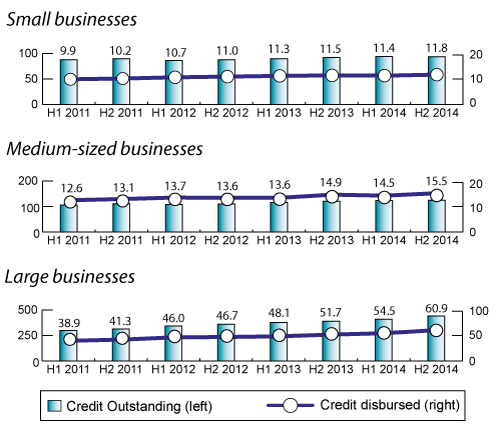
Source: Statistics Canada, Biannual Survey of Suppliers of Business Financing, 2014.
The increase in lending was more pronounced among medium-sized (those with loan authorization levels between$1 million and less than 5 million) and large businesses (those with loan authorization levels of $5 million or more), to which lenders disbursed approximately $15.5 billion and $60.9 billion in new loans respectively. This represented an increase in loan disbursals of 6.7-percent and 11.7-percent respectively from H1 2014 to H2 2014. In contrast, loans disbursed to small businesses (those with loan authorization levels less than $1 million) in H2 2014 ($11.8 billion) increased only 3.3-percent from H1 2014.
Results from the Survey of Suppliers of Business Financing are generally consistent with findings from the PayNet Canadian Business Lending Index (CBLI). As can be seen in Figure 4, index values for small and medium-sized businesses have been trending upwards since 2011. The upward trends generally coincided with decreasing trends in business loan defaults over the period. Specifically, between Q4 2011 and Q4 2014, the loan default rate for small businesses declined by 0.50-percentage points from 1.38 to 0.88, while at the same time the lending index increased by 24.2-percent. Similarly, the loan default rate for medium-sized businesses decreased by 0.51-percentage points from 1.18 to 0.67, while at the same time the lending index increased by 66.2-percent.
Figure 4: Loan Default Rate (percentage) and Canadian Business Lending Index for Small and Medium-Sized Businesses
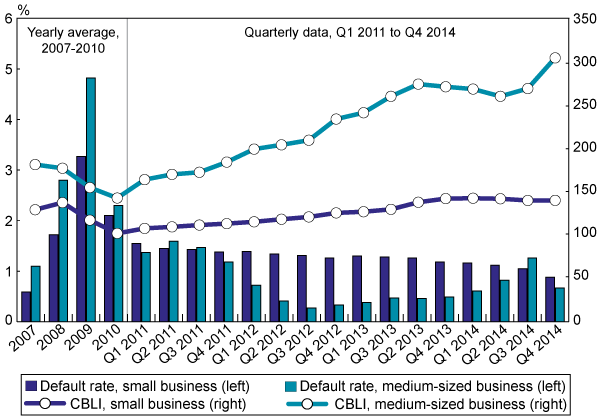
Source: PayNet Inc., Canadian Business Lending Index, 2015.
Note 1: This indicator measures the net volume of loans to small and medium-sized businesses.
Note 2: Defaults are totaled for each quarter and are divided by the average current balance outstanding for the quarter. The result is then annualized. The CBLI is calculated based on the dollar weighted percentage change in qualifying new originations from the prior quarter to the current quarter, for qualifying lenders with data in both quarters. It is then presented on an absolute index basis, indexed so that January 2005 equals 100.
Lending conditions by sector
Findings from the Survey of Suppliers of Business Financing show that there was an increase in total lending across all sectors in the second half of 2014, with the increase in lending most pronounced among large businesses. Sectors experiencing the strongest increase in disbursals were the transportation and warehousing sector and the professional services sector, to which lenders disbursed approximately $4.0 billion and $3.5 billion respectively in new loans in H2 2014. This represents an increase in disbursals of 16.0-percent and 14.6-percent respectively from H1 2014 (Figure 5). This coincided with lower loan default rates in both sectors.
Figure 5: SME Canadian Business Lending Index and Value of Credit Disbursed ($ billions) by Sector to All Businesses
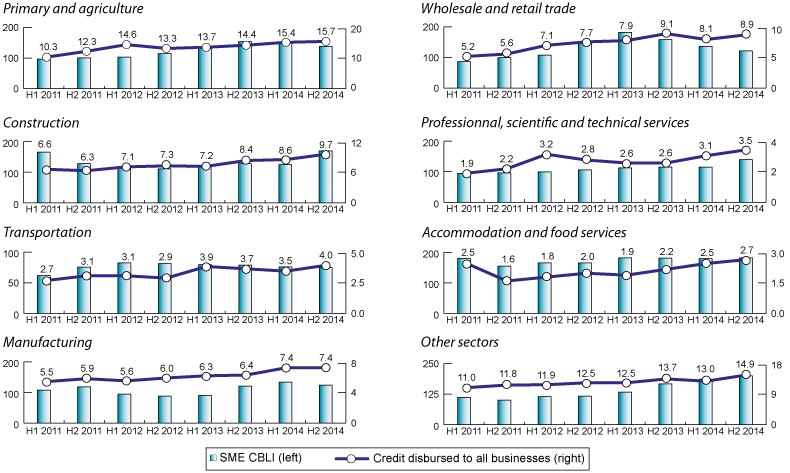
Sources: PayNet Inc., Canadian Business Lending Index, 2015; and Statistics Canada, Biannual Survey of Suppliers of Business Financing, 2014.
Note: Value of credit disbursed to firms in finance, insurance, real estate, and rental sector was excluded from "other sectors".
Firms in the construction sector and the accommodation and food service sector also experienced notable increases in lending activities, with loan disbursals rising by 12.9-percent, and 11.2-percent respectively from H1 2014 to H2 2014. The wholesale and retail sector experienced modest growth of 8.8-percent in total lending. In the same period, SMEs within the wholesale and retail sector, however, experienced a decrease in lending, as evidenced by a 10.6-percent decline in the PayNet Canadian Business Lending Index (SME). Based on the Survey of Suppliers of Business Financing, the manufacturing sector, and the primary and agriculture sector experienced slight total growth in lending of 0.4-percent and 1.8-percent respectively in H2 2014. However, SMEs within both sectors experienced declines of 7.0-percent and 8.8-percent from H1 2014 to H2 2014 based on the results of the PayNet Canadian Business Lending Index (SME).
About the sources
The Statistics Canada Biannual Survey of Suppliers of Business Financing is the result of commitment by the Government of Canada to improve the availability of information about financing of businesses in Canada. Data are collected from 120 major suppliers of financing, including domestic banks and credit unions and Caisses populaires, representing over 90-percent of all lending to businesses in Canada.
The Bank of Canada Senior Loan Officer Survey collects information on the business-lending practices of Canadian financial institutions. In particular, the survey gathers the perspectives of respondents on price and non-price terms of business lending and on topical issues of interest to the Bank of Canada. The survey is conducted quarterly, near the end of the quarter for which the results are reported. The Bank of Canada Business Outlook Survey consist of interviews conducted by the bank's regional offices with the senior management of about 100 firms, selected in accordance with the composition of Canada's gross domestic product. The survey's purpose is to gather the perspectives of these businesses on topics of interest to the Bank of Canada (such as demand and capacity pressures) and their forward-looking views on economic activity.
The PayNet Canadian Business Lending Index is built using PayNet's proprietary database, which is updated weekly, and represents a growing collection of commercial loans and leases encompassing more than 909 thousand reported contracts worth over $70 billion.
This report was prepared by Daniel Seens, CFA, an economist in the Small Business Branch.
